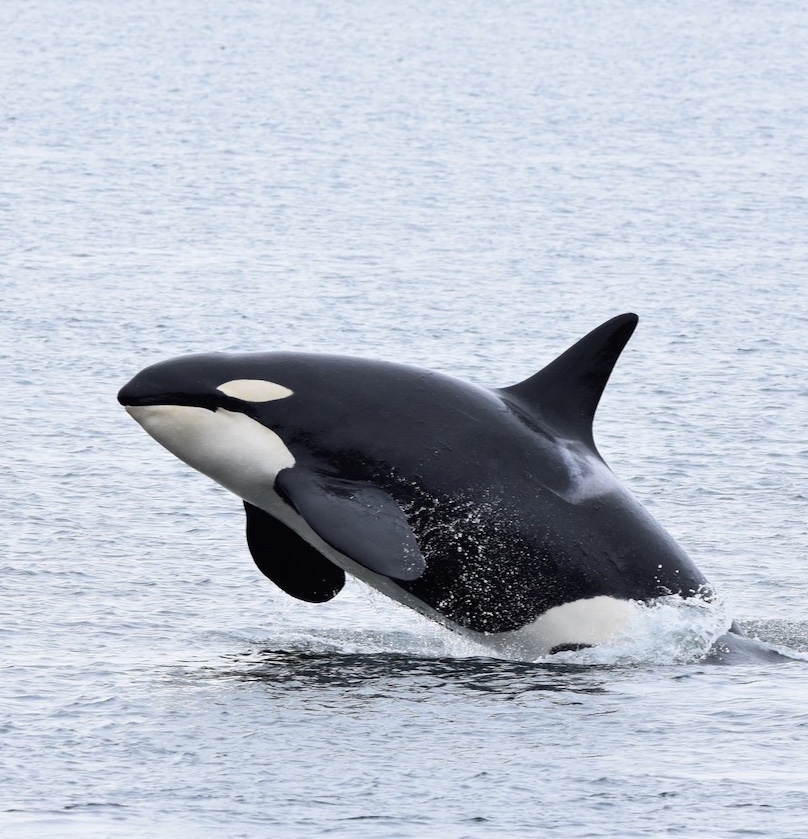UPDATE, JULY 3: Two new reports worth checking out:
—–
“So far, no new babies to report.”
That’s the latest word from Ken Balcomb regarding the southern resident orcas, the three pods of endangered whales that once frequented Puget Sound but lately seem hard to find.
July 1 marks the date of the annual killer whale census, a project carried out by Ken and his fellow researchers at the Center for Whale Research. Each year, Ken accounts for every orca in the population and reports the number to the U.S. government. This has been going on since the 1970s, when the capture of orcas for marine parks was brought to an end.

In the not-so-distant past, the whales would generally return to Puget Sound in late May or June, after hunting for fish along West Coast. In most years, Ken and associates were able to spot every living southern resident orca at least once before July 1. That allowed him to report which whales had died and which ones had given birth.
For the past few years, the orcas have returned late, and often they have stayed a brief time while searching for schools of Chinook salmon, their primary prey. This year, the whales barely showed up at all, so Ken cannot yet tell us the exact status of the population. Under his federal contract, he has until October to report to the National Marine Fisheries Service.
Experts say the whales are missing because the salmon are missing. Fraser River Chinook — the main reason that orcas frequent the San Juan Islands — have dwindled to low levels along with Chinook bound for rivers flowing into North Puget Sound.
One indication of the dire condition for Chinook is the Albion Test Fishery, which involves catching fish in nets off the Fraser River. In June this year, only four fish were caught during the entire month, compared to an average 322 fish caught during the same period from 2000 to 2009.
Roughly half the orcas in the southern resident population have been observed so far this year in one place or another, Ken told me. With some luck, the rest will be spotted this summer. So far, observers have seen no obvious signs of any whales missing from their family groups. We can hope that there will be no deaths to report. But the bad news is that no new baby orcas have been reported either.
More births are needed to maintain the population, let alone expand the number to avoid extinction. If no new births or deaths are reported, the population will stand at 72 animals — with 22 in J pod, 17 in K pod and 32 in L pod. See Orca Network for the full rundown.
Last year, the census showed 73 animals in the population, following four deaths and two births over the previous year. Since then, a 42-year-old male name Mega (L41) was declared missing and presumed dead in January. See Water Ways, Jan. 30, 2020.
Even J pod, known as the homebody group of Puget Sound, has been elsewhere most of the year and not observed in Puget Sound since mid-April. J pod was last seen in Barkley Sound on the west side of Vancouver Island two weeks ago (June 21), according to a Facebook post by Orca Behavior Institute with a video provided by CBC Vancouver.
A portion of L pod, known as the L18s, has been observed near Swiftsure Bank, a prime fishing spot just outside the Strait of Juan de Fuca. Ken noted that a baby born last year, L124 named Whistle, was seen with the group.

Yesterday, two groups from K pod — the K12s and K13s — were seen off the west side of San Juan Island after they entered U.S. waters from Canada. The whales were still in the San Juans today, doing the “westside shuffle,” according to multiple reports.
“The residents are here!” wrote Cindy Hansen, Orca Network’s education coordinator, after spotting the whales. “That phrase has such a different meaning now. What used to be an almost daily occurrence here in the summer is now a momentous occasion that makes you drop absolutely everything you are doing and run out the door to try to catch a glimpse of them, because you don’t know when you’ll get another chance.”
Cindy’s post on Facebook, which received 111 comments by this evening, goes on to express her sudden fears that one or more whales will be missing, her sadness about the whales that have died and her frustration that ongoing human efforts are not enough to create conditions to keep the whales safe at home.
She also describes the excitement of seeing the whales and running into fellow whale enthusiasts, all watching from the shore.
“Even though you chat with some of them almost daily, there is something so special about standing on the rocks and talking and laughing and feeling so grateful to be here with the whales we all love,” she said. “It makes you remember that you aren’t alone and makes the fear and sadness and frustration easier to bear.”

No Comments yet!